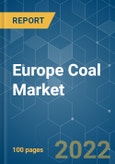The Europe coal market is expected to rise at a CAGR of more than 1.5% during the forecast period of 2020-2025. Factors such as increasing demand for steel production is likely to drive the market. However, a shift from coal-based power generation and efforts to reduce the dependence on coal in various end-user applications across the region are expected to hinder the growth of the market studied.
Key Highlights
- The electricity sector is expected to be the largest user of coal during the forecast period. As many countries are still trying to build new coal-fired power plants, especially in Eastern Europe, where cheap electricity is required, and the presence of the coal basins like Donetsk basin is expected to drive the market.
- New technologies like clean coal are expected to make the coal more eco-friendly and reduce the cost of electricity generated, which, in turn, is likely to make the fuel more reliable and thereby act as an opportunity for the market players.
- Russia is expected to be the largest market for the region's coal market due to increasing investment in the mining sector and the highest consumption and production of coal in the region.
Key Market Trends
Electricity Sector to Dominate the Market
- Although there has been a reduction in usage of coal in most of Europe, new coal-fired thermal power plants are still being built in the region, with some thermal power plants that are still under construction, and few that are being planned for future use.
- Germany is the largest user of coal in the European Union. In June 2020, it launched a coal-fired power plant. The 1,100-MW Datteln-4 power plant is expected to provide cheap electricity to the country and aid the growth of the market. However, due to massive resistance by the public and governmental organizations, many experts believe that it is likely to be among the last coal-fired power plants being built in the country.
- Coal consumption in Europe decreased by 9.05% to 14.98 exajoules, in 2019 from 16.54 exajoule in 2018. At the same time, the production of coal in the region dropped by 4.78% to 15.72 exajoules, in 2019 from 16.51 exajoules, in 2018. This decline in consumption and production is expected to restraint the market.
- A new mine has been opened in Poland, in 2019. The mine is expected to start the extraction of coking coal in 2022. Local deposits of the resource are estimated at some 180 million tonnes. JSW SA is expected to invest more than EUR 684 million in the new facility by 2030, including more than EUR 205 million in the 2019-2022 period. Increasing investment in the sector and growing production of coal is expected to aid the growth of the market.
- Poland and Germany together accounted for more than 60 % of the total hard coal consumption of the European Union in 2019, followed by France and the Netherlands. Hard Coal is a significant type of coal that is used for specific purposes in the electricity sector. Increasing demand for electricity in the countries may aid the growth of the market.
- Hence, the electricity sector is expected to dominate the market in the forecast period due to increasing investments in the sector.
Russia to Dominate the Market
- Coal mining has been a critical industry in Russia for a long time, with production costs among the world's lowest. Combined with high transportation expenditures, primarily on rail transport, those factors make the final price of Russian coal almost comparable to the prices offered by some of Russia's major global competitors, such as Australia and South Africa. However, countries near the Siberian region, like China and South Korea, due to low transportation costs, are the highest importers of coal from the country.
- Russia is exporting substantial amounts of coal to China, which is estimated to be around 32.8 million tons in 2019, yet there remains significant potential for a boost in exports in the forecast period. Similarly, South Korea imported approximately 28.3 million tons of coal in 2019.
- The world's largest coal-producing country, Russia, plans to increase its output and exports over the forecast period with an increasing number of mines being opened. Mining of coal in Russia increased by 1%, to 436992 thousand tons, in 2019 from 432654.2 thousand tons, in 2018.
- In 2019, RusHydro announced the opening of the Sakhalinskaya GRES-2 on Sakhalin Island. New coal-fired plants are being constructed in the country, which aids in the diversification of the fuel and provides for areas where other methods of energy generation are not accessible. The modern 120 MW power plant is expected to replace the obsolete Sakhalinskaya GRES, scheduled for decommissioning in the 2019-2020 period.
- Coal consumption in Europe remained stagnant at 3.63 exajoules in the 2018-2019 period. At the same time, the production of coal in the region dropped by 0.3% to 9.2 exajoules in 2019 from 9.23 exajoules, in 2018. The decrease in consumption and production is expected to restraint the market.
- Hence, Russia is expected to dominate the Europe coal market due to the increasing production of coal and investments in the sector.
Competitive Landscape
The Europe coal market is partially fragmented. Some of the key players in this market include Suek AG, UK Kuzbassrazrezugol OAO, Mitteldeutsche Braunkohlengesellschaft mbH (MIBRAG), Lubelski Wegiel Bogdanka SA, and Jastrzębska Spółka Węglowa SA.
Additional Benefits:
- The market estimate (ME) sheet in Excel format
- 3 months of analyst support
This product will be delivered within 2 business days.
Table of Contents
Methodology

LOADING...








